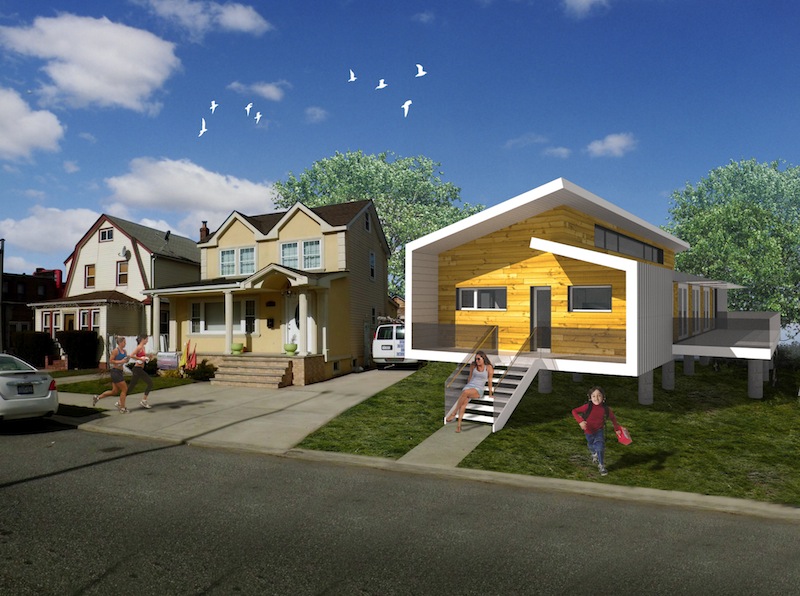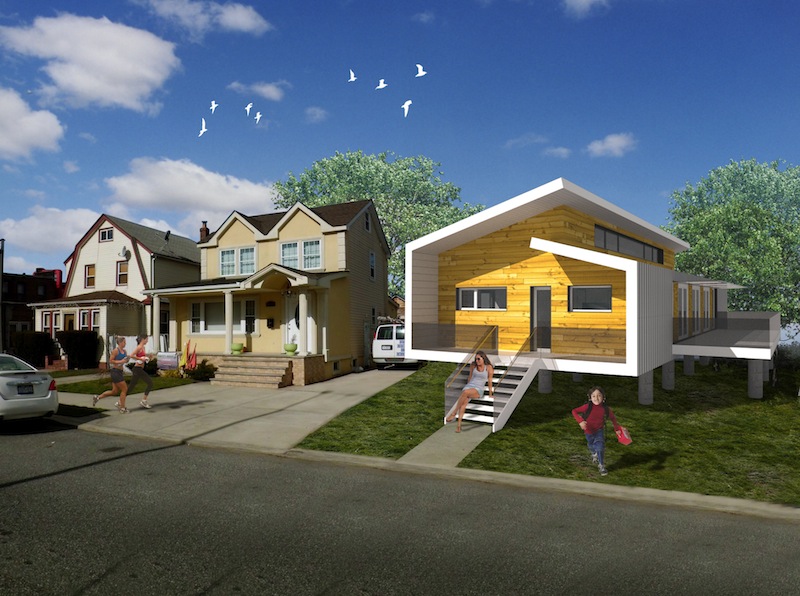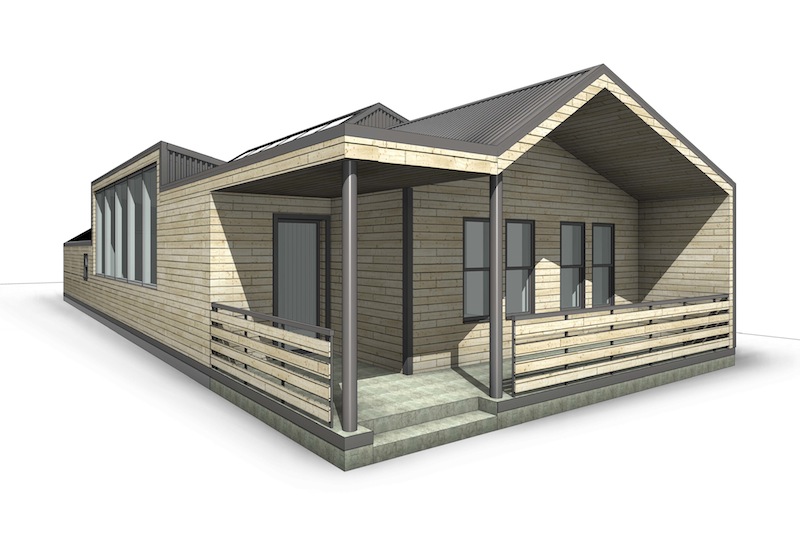The American Institute of Architects, in partnership with Make It Right, St. Bernard Project, Architecture for Humanity and Dow Building Solutions recently concluded “Designing Recovery,” an ideas competition created to aid in the rebuilding of sustainable and resilient communities. The competition was designed to help survivors of recent natural disasters in three distinct settings: New York City, New Orleans, and Joplin, Mo.
“When examining all of the designs submitted we continually asked ourselves if this would be a house we would want to live in regardless of safety considerations,” said Jury Chair, Michael Willis, FAIA, NOMA. “The three designs that we chose all had the ideal combination of addressing disaster mitigation and actual livability. The designs all had the sort of flexibility to be both a resilient safe haven during a natural disaster, but also serve as a dwelling that catered to family conditions and would blend into appropriate neighborhood styles without projecting a ‘bunker-like’ feeling.”
Although there could be just three winning designs, all of the entries that are feasible to construct will go into production in the corresponding communities and include:
1. Shotgun Remix
Designed by GOATstudio LLP, the Shotgun [remix] proposal for New Orleans offers a fresh, contemporary take on a familiar local typology. Modern touches like sliding polycarbonate privacy panels, vaulted interior spaces, clean, modern detailing, an open floor plan, and a steel roof that turns and wraps the southern exterior wall for additional sun protection update the historical shotgun form to better accommodate modern lifestyles and increased environmental challenges.
To help manage the threat from rising sea levels and increasing yearly rainfall, the finish floor will be elevated 7 feet above the ground plane and filter storm runoff through a perimeter rain garden, alleviating on-site ponding and reducing the load on strained city infrastructure. By employing similar construction methodologies and materials as those that have been thoroughly vetted by Make It Right since 2007, the design will be able to achieve LEED Platinum status and provide 6.25 kWh of solar energy to the owners.
2. Resilient House
Designed by Sustainable.TO Architecture + Building, the Resilient House for New York has a layout that orients living spaces towards the sun, and minimizes interior partitions. Structurally insulated panels allow for a tightly sealed and highly insulated building enclosure. Combined with a highly efficient ventilation system and upgraded windows, these design elements project to a 30% reduction in annual energy consumption. The house will be built above the floodplain with a flood-proof foundation to ensure natural disasters will not affect the structure. By using traditional construction methods and equipment, this dwelling can be built for less than $50,000 in material cost.
3. CORE House
Designed by Q4 Architects, CORE House in Joplin, MO is designed to address the local vernacular by combining two single-cell homes: a centrally located "Safe House" acts as the hearth and divides a "Perimeter House." The Safe House contains all of the functions of ‘home’ that are necessary for a family to recover quickly from disaster and live for an extended period of time until rebuilding is possible.
The walls of the Safe House are constructed of filled and anchored carbon-neutral concrete masonry units. Rainwater is collected, stored, and filtered for reuse. Locally sourced building materials were consciously considered so that CORE will have little impact on the progression of climate change, reduce the effects of debris in a natural disaster, and elevate local economies.
About The American Institute of Architects
Founded in 1857, members of the American Institute of Architects consistently work to create more valuable, healthy, secure, and sustainable buildings, neighborhoods, and communities. Through nearly 300 state and local chapters, the AIA advocates for public policies that promote economic vitality and public well-being. Members adhere to a code of ethics and conduct to ensure the highest professional standards. The AIA provides members with tools and resources to assist them in their careers and business as well as engaging civic and government leaders, and the public to find solutions to pressing issues facing our communities, institutions, nation and world. Visit www.aia.org.
About Architecture for Humanity
Architecture for Humanity is a nonprofit design services firm founded in 1999. By building a more sustainable future through the power of professional design, Architecture for Humanity taps a network of more than 75,000 professionals willing to lend time and expertise to help those who would not otherwise be able to afford their services. They bring design, construction and development services where they are most critically needed. For more information, please visit architectureforhumanity.org
St. Bernard Project
St. Bernard Project (SBP) is an award-winning rebuilding, nonprofit organization whose mission is to ensure that disaster-impacted citizens and communities recover in a prompt, efficient and predictable manner. Through its Disaster Recovery Lab, SBP works to share lessons learned, prevent common barriers to recovery, and help communities utilize SBP’s standardized, repeatable and proven-effective model. Since its founding in 2006, SBP has rebuilt homes for over 600 families in greater New Orleans, Louisiana and Joplin, Missouri with the help of 50,000 volunteers. In the wake of Hurricane Sandy, SBP is working on the ground in Rockaway and Staten Island, New York to help displaced families rebuild their homes and rebuild their lives. For more information, visit stbernardproject.org and sandy.stbernardproject.org.
Make It Right
Founded by Brad Pitt, Make It Right builds healthy, Cradle to Cradle-inspired homes, buildings and communities for people in need. Make It Right is currently working in New Orleans, LA, Newark, NJ, Kansas City, MO and the Fort Peck Reservation, MT. Learn more at www.makeitright.org.
Dow Building Solutions
Dow Building Solutions has a 60+ year legacy of providing energy saving solutions to the construction industry, which began with the launch of STYROFOAM™ Brand Extruded Polystyrene Foam Insulation. A business unit of The Dow Chemical Company, Dow Building Solutions offers insulation, air sealing and weatherization solutions to improve the performance of homes and buildings and reduce energy costs while contributing to the reduction of greenhouse gas emissions. Visit www.dowbuildingsolutions.com.
Related Stories
| Oct 13, 2010
Residences bring students, faculty together in the Middle East
A new residence complex is in design for United Arab Emirates University in Al Ain, UAE, near Abu Dhabi. Plans for the 120-acre mixed-use development include 710 clustered townhomes and apartments for students and faculty and common areas for community activities.
| Oct 13, 2010
HQ renovations aim for modern look
Gerner Kronick + Valcarcel Architects’ renovations to the Commonwealth Bank of Australia’s New York City headquarters will feature a reworked reception lobby with back-painted glass, silk-screened logos, and a video wall.
| Oct 13, 2010
New health center to focus on education and awareness
Construction is getting pumped up at the new Anschutz Health and Wellness Center at the University of Colorado, Denver. The four-story, 94,000-sf building will focus on healthy lifestyles and disease prevention.
| Oct 13, 2010
Community center under way in NYC seeks LEED Platinum
A curving, 550-foot-long glass arcade dubbed the “Wall of Light” is the standout architectural and sustainable feature of the Battery Park City Community Center, a 60,000-sf complex located in a two-tower residential Lower Manhattan complex. Hanrahan Meyers Architects designed the glass arcade to act as a passive energy system, bringing natural light into all interior spaces.
| Oct 13, 2010
Community college plans new campus building
Construction is moving along on Hudson County Community College’s North Hudson Campus Center in Union City, N.J. The seven-story, 92,000-sf building will be the first higher education facility in the city.
| Oct 13, 2010
Bookworms in Silver Spring getting new library
The residents of Silver Spring, Md., will soon have a new 112,000-sf library. The project is aiming for LEED Silver certification.
| Oct 13, 2010
County building aims for the sun, shade
The 187,032-sf East County Hall of Justice in Dublin, Calif., will be oriented to take advantage of daylighting, with exterior sunshades preventing unwanted heat gain and glare. The building is targeting LEED Silver. Strong horizontal massing helps both buildings better match their low-rise and residential neighbors.
| Oct 12, 2010
Holton Career and Resource Center, Durham, N.C.
27th Annual Reconstruction Awards—Special Recognition. Early in the current decade, violence within the community of Northeast Central Durham, N.C., escalated to the point where school safety officers at Holton Junior High School feared for their own safety. The school eventually closed and the property sat vacant for five years.
| Oct 12, 2010
Guardian Building, Detroit, Mich.
27th Annual Reconstruction Awards—Special Recognition. The relocation and consolidation of hundreds of employees from seven departments of Wayne County, Mich., into the historic Guardian Building in downtown Detroit is a refreshing tale of smart government planning and clever financial management that will benefit taxpayers in the economically distressed region for years to come.
| Oct 12, 2010
Richmond CenterStage, Richmond, Va.
27th Annual Reconstruction Awards—Bronze Award. The Richmond CenterStage opened in 1928 in the Virginia capital as a grand movie palace named Loew’s Theatre. It was reinvented in 1983 as a performing arts center known as Carpenter Theatre and hobbled along until 2004, when the crumbling venue was mercifully shuttered.




















